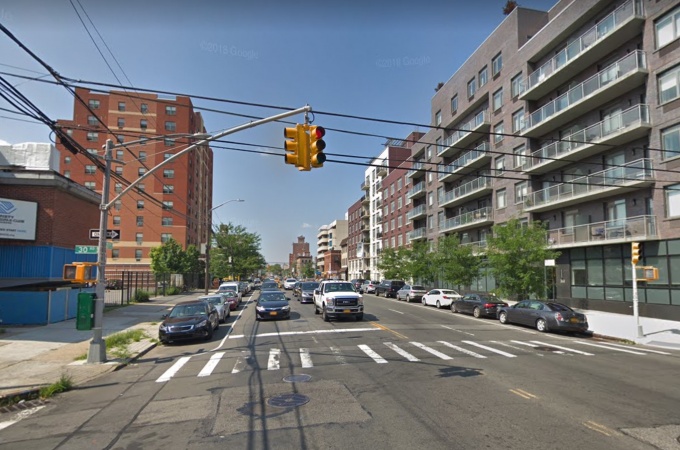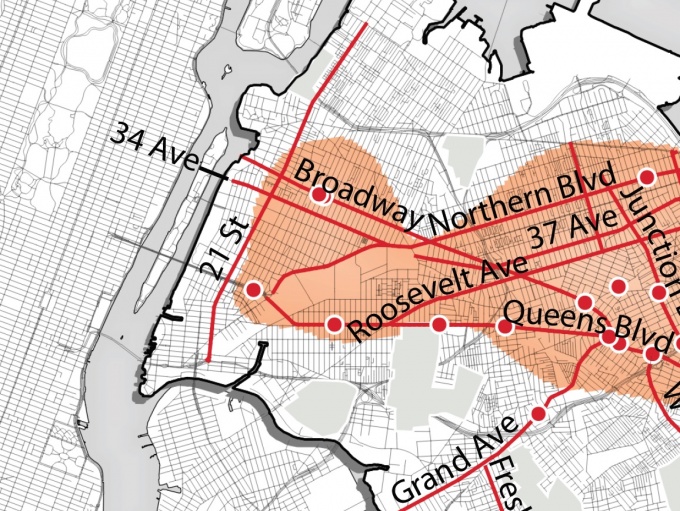
21st Street and 30th Road, where a 45-year-old man was killed in a hit-and-run in 2016. The DOT has listed nearly the entire length of the stretch as a priority corridor in its new vision zero plan. (Google Maps)
Feb. 20, 2019 By Nathaly Pesantez
A new Vision Zero plan released yesterday lists 21st Street, running between Astoria and Long Island City, among several priority corridors in the five boroughs that have proven dangerous and are now the focus of new safety initiatives by the city.
The Department of Transportation added the 3.6-mile length of 21st Street between 50th and 20th Avenues in its updated Borough Pedestrian Safety Action Plans, which outline priority corridors, intersections and areas that combined have made up a significant portion of all pedestrian fatalities and injuries over the years.
“In these updated plans, we have used the freshest data to identify new crash-prone corridors and intersections most in need of our full menu of safety interventions,” said Polly Trottenberg, DOT Commissioner.
The 21st Street length is part of 424 miles of priority corridors in the five boroughs that, despite making up 7 percent of city streets, are responsible for nearly half of total pedestrian fatalities citywide. The Astoria and Long Island City stretch is also among 114 miles of priority corridors in Queens that saw roughly half of all pedestrian fatalities in the borough.
The DOT said 21st Street, along the near 50-block length, saw 4.2 pedestrians killed or severely injured per mile from 2012 to 2016, a whopping 50 percent jump from the 2.8 KSI figure recorded between 2009 and 2013 on the street.

The 21st Street priority corridor, among other priority intersections and areas selected by the DOT for safety interventions. (DOT)
The stretch saw two pedestrians die from 2012 to 2016, while 14 pedestrians were severely injured during the time frame.
The street is part of five new corridors in Queens the DOT is targeting for immediate and long-term safety interventions. The new corridors are also among 30 streets and avenues in Queens the agency is still keeping its sights on after listing them in its Vision Zero roll out four years ago, like Queens Boulevard, Main Street, Roosevelt Avenue and Northern Boulevard.
Citywide, 293 priority intersections have been selected (68 of which are in Queens) and 60 square miles of priority areas.
To up safety at the priority corridors, the DOT will be adding Leading Pedestrian Interval Signals, which show walk signs for pedestrians before showing a green light to vehicles, “at every feasible intersection” by the end of 2019.
Signal timing will also be modified to reduce speeding “on all feasible new priority corridors” by the end of the year.
The agency will also focus on long-term efforts like tracking vision zero violations at the priority locations to better pinpoint where and how problems arise, enhancing NYPD and DOT presence at corridors, and launching other outreach and safety awareness programs.
The action plans, save for the LPI installation and signal timing modifications, will be rolled out over the next three years.
While 21st Street is now a priority corridor, the stretch has been a problem area for years, with many calls made to make the street safer.
The DOT implemented some increased safety measures on parts of the street in 2015 given the staggering number of pedestrian injuries and deaths reported in prior years, but the injuries and deaths have notably continued on the stretch.
In 2016, a traffic light was installed at the corner of 21st Street and 30th Road, where a 45-year-old pedestrian was killed in a hit-and-run months before. The agency, however, had rejected calls for a stoplight at the location just a year prior, saying it didn’t meet the criteria at the time.
And while outside of the crash data the DOT used in its priority corridor selection, a pedestrian died in 2017 days after she was struck by a car while crossing the street at 40th Avenue.
One Comment

i live right off 21st st on 41 ave and twice a day i go up 21st to 30th ave to drop off and pickup my kid at daycare. this has been my daily routine for 3 years and this is what i’ve noticed as the problems on this stretch. 1.) overall the cars drive way too fast up and down 21st. 2.)there are a lot of bus stops along this stretch with crowds of people waiting for the buses on both sides of the street. esp during rush hours. 3.)a number of auto body/mechanic shops along this stretch with a lot of cars coming in and out and double parking. with the buses and busy businesses with the ins and outs this 2 lane easily becomes one lane and everyone trying to get in that lane and speed around the stopped lanes. its chaos. i’ve also witnessed, almost daily, pedestrians crossing this road at their leisure whereever they feel. cars are zipping up this road constantly. i’ve also witnessed people darting across the road to catch a bus coming the other way because the lights are too long. i’ve been that guy, see the bus 5 blocks away and just knowing i’m going to miss it because i’m on the other side of the street…and maybe there wont be another bus for 20 mins. when its cold, you want to catch that bus. its like a perfect storm of speeding for cars and rushing for pedestrians. some pedestrian bridges might be of service esp near large intersections where buses stop. lose a stop light and add a bridge. i dont know.